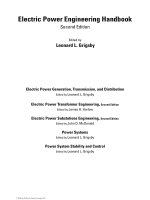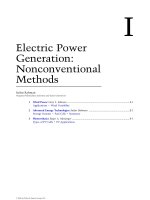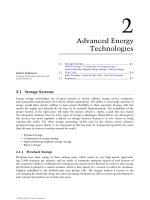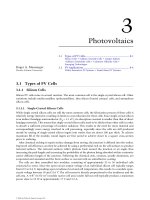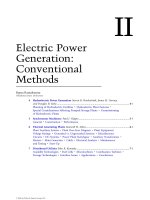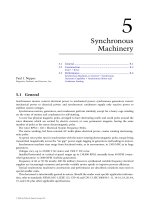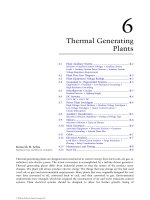power system stability and control chuong (7)
Bạn đang xem bản rút gọn của tài liệu. Xem và tải ngay bản đầy đủ của tài liệu tại đây (464.18 KB, 8 trang )
5
Synchronous
Machinery
Paul I. Nippes
Magnetic Products and Services, Inc.
5.1 General 5-1
5.2 Construction 5-2
Stator
.
Rotor
5.3 Performance 5-4
Synchronous Machines, in General
.
Synchronous
Generator Capability
.
Synchronous Motor and
Condenser Starting
5.1 General
Synchronous motors convert electrical power to mechanical power; synchronous generators convert
mechanical power to electrical power; and synchronous condensers supply only reactive power to
stabilize system voltages.
Synchronous motors, generators, and condensers perform similarly, except for a heavy cage winding
on the rotor of motors and condensers for self-starting.
A rotor has physical magnetic poles, arranged to have alternating north and south poles around the
rotor diameter which are excited by electric current, or uses permanent magnets, having the same
number of poles as the stator electromagnetic poles.
The rotor RPM ¼ 120 Â Electrical System Frequency=Poles.
The stator winding, fed from external AC multi-phase electrical power, creates rotating electromag-
netic poles.
At speed, rotor poles turn in synchronism with the stator rotating electromagnetic poles, torque being
transmitted magnetically across the ‘‘air gap’’ power angle, lagging in generators and leading in motors.
Synchronous machine sizes range from fractional watts, as in servomotors, to 1500 MW, as in large
generators.
Voltages vary, up to 25,000 V AC stator and 1500 V DC rotor.
Installed horizontal or vertical at speed ranges up to 130,000 RPM, normally from 40 RPM (water-
wheel generators) to 3600 RPM (turbine generators).
Frequency at 60 or 50 Hz mostly, 400 Hz military; however, synthesized variable frequency electrical
supplies are increasingly common and provide variable motor speeds to improve process efficiency.
Typical synchronous machinery construction and performance are described; variations may exist on
special smaller units.
This document is intentionally general in nature. Should the reader want specific application informa-
tion, refer to standards: NEMA MG-1; IEEE 115, C50-10 and C50-13; IEC 600034: 1-11, 14-16, 18, 20, 44,
72, and 136, plus other applicable specifications.
ß 2006 by Taylor & Francis Group, LLC.
5.2 Construction (See Fig. 5.1)
5.2.1 Stator
5.2.1.1 Frame
The exterior frame, made of steel, either cast or a weldment, supports the laminated stator core and has
feet, or flanges, for mounting to the foundation. Frame vibration from core magnetic forcing or rotor
unbalance is minimized by resilient mounting the core and=or by designing to avoid frame resonance
with forcing frequencies. If bracket type bearings are employed, the frame must support the bearings, oil
seals, and gas seals when cooled with hydrogen or gas other than air. The frame also provides protection
from the elements and channels cooling air, or gas, into and out of the core, stator windings, and rotor.
When the unit is cooled by gas contained within the frame, heat from losses is removed by coolers
having water circulating through finned pipes of a heat exchanger mounted within the frame. Where
cooling water is unavailable and outside air cannot circulate through the frame because of its dirty or
toxic condition, large air-to-air heat exchangers are employed, the outside air being forced through the
cooler by an externally shaft-mounted blower.
5.2.1.2 Stator Core Assembly
The stator core assembly of a synchronous machine is almost identical to that of an induction motor.
A major component of the stator core assembly is the core itself, providing a high permeability path for
magnetism. The stator core is comprised of thin silicon steel laminations and insulated by a surface
coating minimizing eddy current and hysteresis losses generated by alternating magnetism. The lamin-
ations are stacked as full rings or segments, in accurate alignment, either in a fixture or in the stator
frame, having ventilation spacers inserted periodically along the core length. The completed core is
compressed and clamped axially to about 10 kg=cm
2
using end fingers and heavy clamping plates. Core
end heating from stray magnetism is minimized, especially on larger machines, by using non-magnetic
materials at the core end or by installing a flux shield of either tapered laminations or copper shielding.
FIGURE 5.1 Magnetic ‘‘skeleton’’ (upper half) and structural parts (lower half) of a ten-pole (720 rpm at 60
cycles) synchronous motor. (From The ABC’s of Synchronous Motors, 7(1), 5, 1944. The Electric Machinery
Company, Inc. With permission.)
ß 2006 by Taylor & Francis Group, LLC.
A second major component is the stator winding made up of insulated coils placed in axial slots of
the stator core inside diameter. The coil make-up, pitch, and connections are designed to produce
rotating stator electromagnetic poles in synchronism with the rotor magnetic poles. The stator coils are
retained into the slots by slot wedges driven into grooves in the top of the stator slots. Coil end windings
are bound together and to core-end support brackets. If the synchronous machine is a generator, the
rotating rotor pole magnetism generates voltage in the stator winding which delivers power to an electric
load. If the synchronous machine is a motor, its electrically powered stator winding generates rotating
electromagnetic poles and the attraction of the rotor magnets, operating in synchronism, produces
torque and delivery of mechanical power to the drive shaft.
5.2.2 Rotor
5.2.2.1 The Rotor Assembly
The rotor of a synchronous machine is a highly engineered unitized assembly capable of rotating
satisfactorily at synchronous speed continuously according to standards or as necessary for the appli-
cation. The central element is the shaft, having journals to support the rotor assembly in bearings.
Located at the rotor assembly axial mid-section is the rotor core embodying magnetic poles. When the
rotor is round it is called ‘‘non-salient pole’’, or turbine generator type construction and when the rotor
has protruding pole assemblies, it is called ‘‘salient pole’’ construction.
The non-salient pole construction, used mainly on turbine generators (and also as wind tunnel fan
drive motors), has two or four magnetic poles created by direct current in coils located in slots at the
rotor outside diameter. Coils are restrained in the slots by slot wedges and at the ends by retaining rings
on large high-speed rotors, and fiberglass tape on other units where stresses permit. This construction is
not suited for use on a motor requiring self-starting as the rotor surface, wedges, and retaining rings
overheat and melt from high currents of self-starting.
A single piece forging is sometimes used on salient pole machines, usually with four or six poles.
Salient poles can also be integral with the rotor lamination and can be mounted directly to the shaft or
fastened to an intermediate rotor spider. Each distinct pole has an exciting coil around it carrying
excitation current or else it employs permanent magnets. In a generator, a moderate cage winding in
the face of the rotor poles, usually with pole-to-pole connections, is employed to dampen shaft torsional
oscillation and to suppress harmonic variation in the magnetic waveform. In a motor, heavy bars and end
connections are required in the pole face to minimize and withstand the high heat of starting duty.
Direct current excites the rotor windings of salient, and non-salient pole motors and generators,
except when permanent magnets are employed. The excitation current is supplied to the rotor from
either an external DC supply through collector rings or a shaft-mounted brushless exciter. Positive and
negative polarity bus bars or cables pass along and through the shaft as required to supply excitation
current to the windings of the field poles.
When supplied through collector rings, the DC current could come from a shaft-driven DC or AC
exciter rectified output, from an AC-DC motor-generator set, or from plant power. DC current supplied
by a shaft-mounted AC generator is rectified by a shaft-mounted rectifier assembly.
As a generator, excitation current level is controlled by the voltage regulator. As a motor, excitation
current is either set at a fixed value, or is controlled to regulate power factor, motor current, or system
stability.
In addition, the rotor also has shaft-mounted fans or blowers for cooling and heat removal from the
unit plus provision for making balance weight additions or corrections.
5.2.2.2 Bearings and Couplings
Bearings on synchronous machinery are anti-friction, grease, or oil-lubricated on smaller machines, journal
type oil-lubricated on large machines, and tilt-pad type on more sophisticated machines, especially
where rotor dynamics are critical. Successful performance of magnetic bearings, proving to be successful
on turbo-machinery, may also come to be used on synchronous machinery as well.
ß 2006 by Taylor & Francis Group, LLC.
As with bearings on all large electrical machinery, precautions are taken with synchronous machines
to prevent bearing damage from stray electrical shaft currents. An elementary measure is the application
of insulation on the outboard bearing, if a single-shaft end unit, and on both bearing and coupling at
the same shaft end for double-shaft end drive units. Damage can occur to bearings even with properly
applied insulation, when solid-state controllers of variable frequency drives, or excitation, cause currents
at high frequencies to pass through the bearing insulation as if it were a capacitor. Shaft grounding and
shaft voltage and grounding current monitoring can be employed to predict and prevent bearing
and other problems.
5.3 Performance
5.3.1 Synchronous Machines, in General
This section covers performance common to synchronous motors, generators, and condensers.
Saturation curves (Fig. 5.2) are either calculated or obtained from test and are the basic indicators
of machine design suitability. From these the full load field, or excitation, amperes for either motors
PER UNIT FIELD AMPERES
PER UNIT ARMATURE AMPERES
PER UNIT TERMINAL VOLTS
4.0
0
.2
.4
.6
.8
1.0
1.2
3.02.01.00
0
.2
.4
.6
.8
1.0
1.2
1.4
"B"
"A"
ZERO P.F.
SATURATION
NO LOAD
SATURATION
RATED
LOAD
SHORT- CIRCUIT
SATURATION
FIGURE 5.2 Saturation curves.
ß 2006 by Taylor & Francis Group, LLC.
or generators are determined as shown, on the rated voltage line, as ‘‘Rated Load.’’ For
synchronous condensers, the field current is at the crossing of the zero P.F. saturation line at 1.0 V.
As an approximate magnetic figure of merit, the no-load saturation curve should not exceed its
extrapolated straight line by more than 25%, unless of a special design. From these criteria, and the
knowledge of the stator current and cooling system effectiveness, the manufacturer can project
the motor component heating, and thus insulation life, and the efficiency of the machine at
different loads.
Vee curves (Fig. 5.3) show overall loading performance of a synchronous machine for different loads
and power factors, but more importantly show how heating and stability limit loads. For increased
hydrogen pressures in a generator frame, the load capability increases markedly.
The characteristics of all synchronous machines when their stator terminals are short-circuited are
similar (see Fig. 5.4). There is an initial subtransient period of current increase of 8 to 10 times rated,
with one phase offsetting an equal amount. These decay in a matter of milliseconds to a transient value
of 3 to 5 times rated, decaying in tenths of a second to a relatively steady value. Coincident with this, the
PER UNIT FIELD AMPERES
0.95 PF LEAD
1.0 PF
0.0 PF LEAD
PER UNIT kVA
0
0
0.2
0.4
0.6
0.8
1.0
1.2
1.4
1.0 2.0 3.0 4.0
LIMITED BY
FIELD HEATING
LIMITED BY
ARMATURE
HEATING
LIMITED BY
END HEATING
30 PSIG H
2
0.9 PF LAG
0.0 PF LAG
60 PSIG H
2
45 PSIG H
2
FIGURE 5.3 Vee curves.
ß 2006 by Taylor & Francis Group, LLC.
field current increases suddenly by 3 to 5 times, decaying in tenths of a second. The stator voltage on
the shorted phases drops to zero and remains so until the short circuit is cleared.
5.3.2 Synchronous Generator Capability
The synchronous generator normally has easy starting duty as it is brought up to speed by a
prime mover. Then the rotor excitation winding is powered with DC current, adjusted to rated
voltage, and transferred to voltage regulator control. It is then synchronized to the power
system, closing the interconnecting circuit breaker as the prime mover speed is advancing, at a
snail’s pace, leading the electric system. Once on line, its speed is synchronized with the power
system and KW is raised by increasing the prime mover KW input. The voltage regulator adjusts
excitation current to hold voltage. Increasing the voltage regulator set point increases KVAR input
to the system, reducing the power factor toward lagging and vice versa. Steady operating limits
are provided by its Reactive Capability Curve (see Fig. 5.5). This curve shows the possible kVA
reactive loading, lagging, or leading, for given KW loading. Limitations consist of field heating,
armature heating, stator core end heating, and operating stability over different regions of the reactive
capability curve.
5.3.3 Synchronous Motor and Condenser Starting
The duty on self-starting synchronous motors and condensors is severe, as there are large
induction currents in the starting cage winding once the stator winding is energized (see Fig. 5.6).
Voltage -Phase A
Voltage
-Phase B
Voltage -Phase C
Field current
Current-Phase C
Current-Phase B
Current-Phase A
FIGURE 5.4 Typical oscillogram of a sudden three-phase short circuit.
ß 2006 by Taylor & Francis Group, LLC.
These persist as the motor comes up to speed, similar to but not identical to starting an
induction motor. Similarities exist to the extent that extremely high torque impacts the rotor
initially and decays rapidly to an average value, increasing with time. Different from the
induction motor is the presence of a large oscillating torque. The oscillating torque decreases in
frequency as the rotor speed increases. This oscillating frequency is caused by the saliency effect of
the protruding poles on the rotor. Meanwhile, the stator current remains constant until 80% speed
is reached. The oscillating torque at decaying frequency may excite train torsional natural
frequencies during acceleration, a serious train design consideration. An anomaly occurs at half
speed as a dip in torque and current due to the coincidence of line frequency torque with oscillating
torque frequency. Once the rotor is close to rated speed, excitation is applied to the field coils and the
rotor pulls into synchronism with the rotating electromagnetic poles. At this point, stable steady-state
operation begins.
Increasingly, variable frequency power is supplied to synchronous machinery primarily to deliver the
optimum motor speed to meet load requirements, improving the process efficiency. It can also be used
LIMITED BY
END HEATING
LEADING
PER UNIT kVARS
LAGGING
PER UNIT kW
STATIC STABILITY LIMIT
0.8
0.6
0.4
0.2
0.2 0.4 0.6 0.8 1.0
0.0
0.2
0.4
0.6
0.8
LIMITED BY
FIELD HEATING
LIMITED BY
ARMATURE HEATING
6
0
P
S
I
G
(
5
.
1
4
9
6
6
ϫ
1
0
5
N
/
m
2
)
H
2
4
5
P
S
I
G
(
4
.
1
1
5
5
3
ϫ
1
0
5
N
/
m
2
)
H
2
3
0
P
S
I
G
(
3
.
0
8
1
4
1
ϫ
1
0
5
N
/
m
2
)
H
2
RATED PF
FIGURE 5.5 Typical reactive capability curve.
ß 2006 by Taylor & Francis Group, LLC.
for soft-starting the synchronous motor or condenser. Special design and control are employed to avert
problems imposed, such as excitation of train torsional natural frequencies and extra heating from
harmonics of the supply power.
TIME (SECOND)
CURRENT (PU) GAP TORQUE (PU) SPEED (%)
0.0
−10.0
−8.0
−6.0
−4.0
−2.0
0.0
2.0
4.0
6.0
−3.0
−2.0
−1.0
0.0
1.0
2.0
3.0
4.0
0.0
20.0
40.0
60.0
80.0
100.0
1.0 2.0 3.0 4.0 5.0 6.0 7.0 8.0 9.0 10.0
FIGURE 5.6 Synchronous motor and condensor starting.
ß 2006 by Taylor & Francis Group, LLC.



